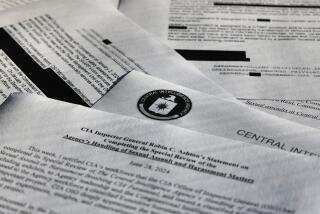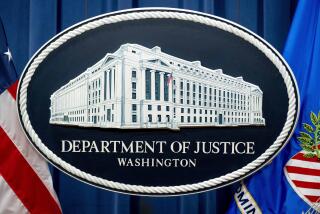Suspected Spy in CIA Reportedly Unmasked
WASHINGTON — The Central Intelligence Agency recently uncovered another suspected foreign spy in its midst but chose to handle the espionage case through administrative action and keep the matter secret, according to U.S. intelligence sources.
CIA sources said the agency discovered that a contract employee working closely with its clandestine case officers apparently was providing information to a foreign intelligence service. The CIA brought in the FBI to aid in a counterintelligence investigation but sufficient evidence could not be obtained for an arrest. Instead, the worker was fired.
The CIA notified congressional intelligence oversight committees but, unlike other recent high-profile spy cases, the agency decided not to make a public announcement that a spy had been unmasked.
U.S. intelligence sources said that the contract employee was spying for what the CIA calls a “hard-target” country--such as China, Russia, Iran or Iraq--but declined to identify the nation.
The contract employee was a foreign citizen but his nationality could not be determined. It was also not clear whether the worker had been forced to leave the country. Information about the case remains closely guarded and sources declined to provide many details. The CIA refused to comment.
But sources said the case first surfaced as the CIA was beginning its secret mole hunt in 1995 and early 1996, and which ultimately led to last November’s arrest of Harold James Nicholson, the highest-ranking CIA officer caught spying for a foreign country. Nicholson was a former CIA station chief who began spying for Moscow in 1994 while based in Malaysia. U.S. intelligence sources now acknowledge that they began to pick up “inferences” from stations around the world suggesting a serious counterintelligence problem in 1995, long before they were able to identify Nicholson.
If this second case had been disclosed at the time the Nicholson case was announced, it would have been highly embarrassing to the agency and heightened the impression that the CIA was riddled with security and management problems.
Yet, U.S. intelligence sources stressed that the contract worker was revealed to be a spy relatively quickly, after just a few months on the job, and that the case represents a counterintelligence success story. The CIA and the FBI cooperated fully--one source said the FBI put the contract employee under surveillance--underscoring that the interagency turf problems that once plagued espionage investigations are now largely a thing of the past.
Distrust between the CIA and the FBI helped Aldrich H. Ames, who spied for the Soviet Union and Russia, go undetected inside the CIA for nine years, until his arrest in 1994. The controversy surrounding the Ames case prompted a comprehensive reform of CIA and FBI methods for catching spies. FBI officials are now stationed full time at the Counterintelligence Center at CIA headquarters in Langley, Va.
Sources also said that the damage the suspected spy was able to do to the CIA appears to have been limited. Although the employee’s job description could not be confirmed, one source said he believed the contract worker was a foreign language instructor hired to teach a difficult language to CIA case officers preparing for overseas assignments. The case officers were said to be already under cover so the contract worker would not have known their true names. A source said that the contract worker asked too many questions of the CIA officers, one reason the agency was suspicious.
A source said that the case was considered a minor problem when it surfaced, since the agency’s counterintelligence experts were focused on the much more damaging case involving Nicholson. While the CIA and FBI in the past have suggested that Nicholson was tripped up largely by a routine lie-detector test given periodically to CIA officers, sources said that in fact an intense internal mole hunt had been underway for some time. Once Nicholson’s name surfaced as a suspect, he was given a lie-detector test that he was told was part of his routine reexamination. But, in fact, his turn for submitting to a polygraph had been accelerated by the agency’s spy hunters.
CIA and FBI officials had to manage the Nicholson case closely for months before his arrest--in part because he was about to become an overseas station chief, promoted by supervisors who were unaware of the espionage investigation--and the CIA had to find a way to keep him in the United States without raising his suspicions. The Nicholson case thus required a level of attention not needed in the case of the contract employee.
The last year has seen an unusually large number of espionage cases, which U.S. intelligence officials attribute largely to their improved ability to apprehend spies.
Nicholson, who was arrested last November at Washington’s Dulles International Airport while on his way to see his Russian handlers in Switzerland, pleaded guilty in March. Last week, he was sentenced to 23 1/2 years in federal prison.
In December, FBI agent Earl Pitts was arrested for selling secrets to Moscow; he pleaded guilty in February and is scheduled to be sentenced soon.
Robert C. Kim, a civilian computer expert in the Office of Naval Intelligence, pleaded guilty in May to spying for his native South Korea.
And on Tuesday, Kelly Therese Warren, a former U.S. Army clerk, was arrested in Florida on charges that she was part of an Army spy ring in Germany that passed military secrets to Hungarian and Czech agents in the mid-1980s.
More to Read
Sign up for Essential California
The most important California stories and recommendations in your inbox every morning.
You may occasionally receive promotional content from the Los Angeles Times.










